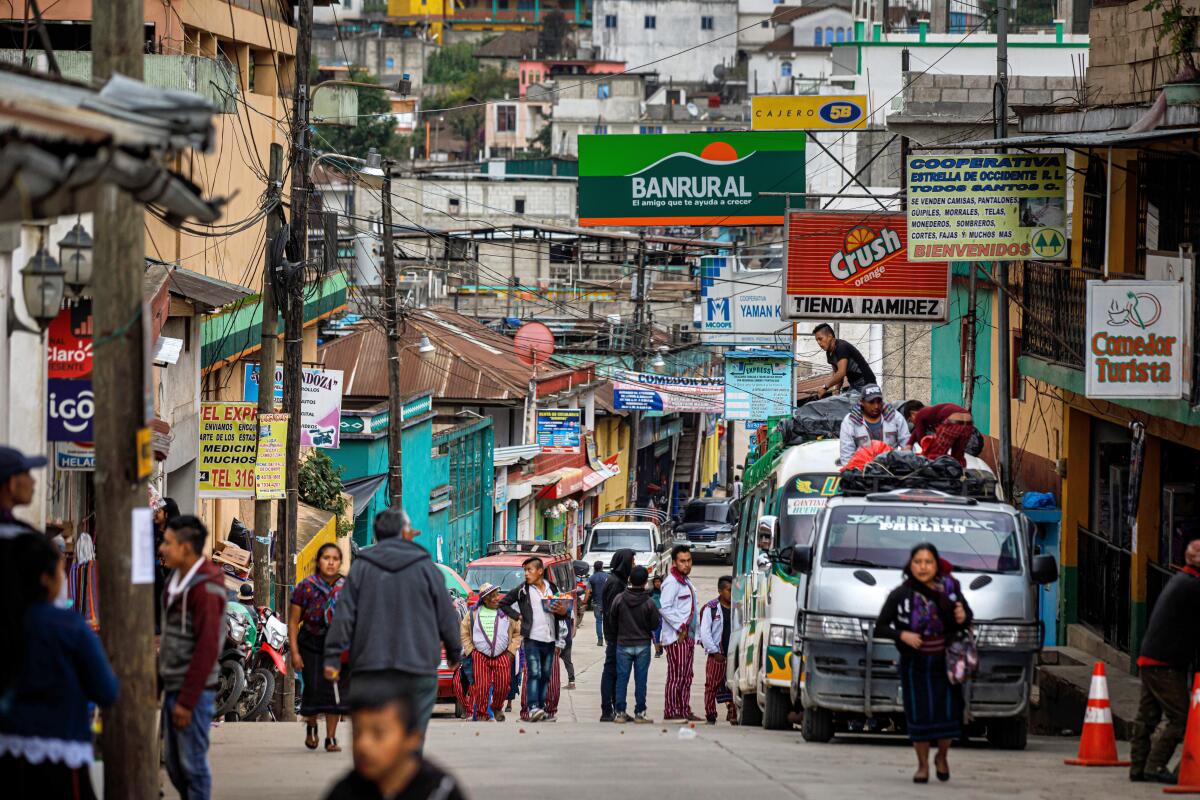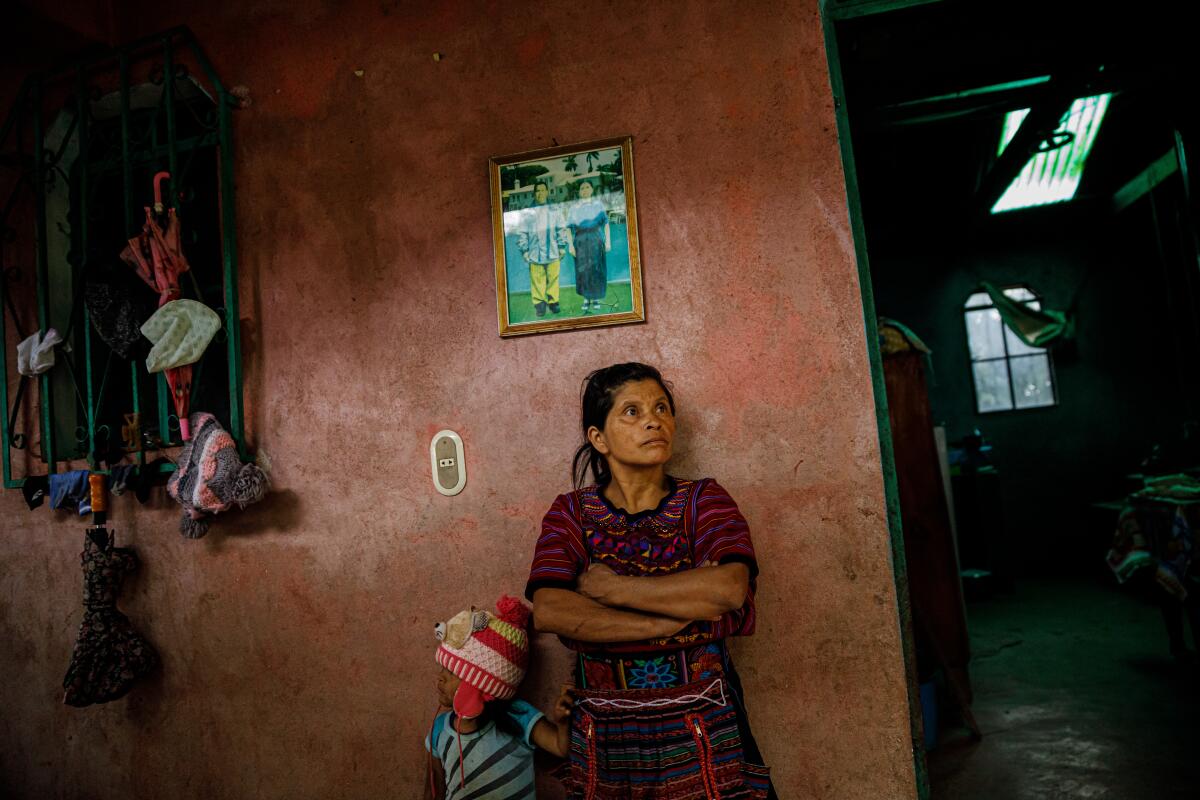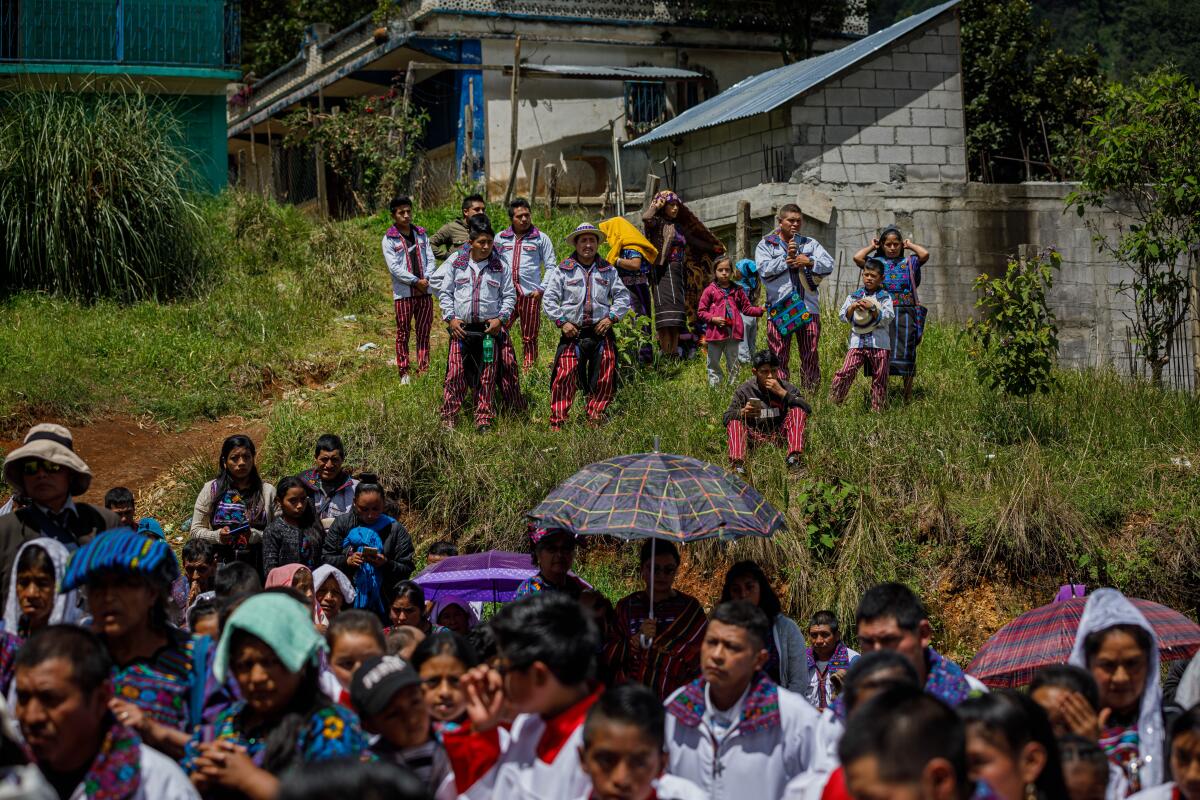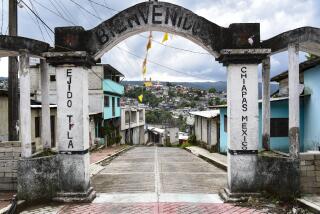To folks in this Guatemalan town, success stories start with a trek to the U.S.

- Share via
TODOS SANTOS CUCHUMATAN, Guatemala — This mist-shrouded mountain town in northwest Guatemala exudes a bustling air of good fortune, even prosperity, that may seem at odds with the landscape of subsistence cornfields and vegetable plots.
Concrete and stucco houses of three and even four stories tower over traditional dwellings crafted from adobe bricks and wooden planks.
The source of the housing boom isn’t income from crop sales or occasional tourism. Rather, Todos Santos runs on savings sent home from the United States.
“The United States helped me more than the Guatemala government ever did,” said Efrain Carrillo, 40, outside the three-story house he built with three years of savings from working in the north as a laborer a decade ago. “I was deported, but I am grateful to the United States.”
The house features a ground-floor grocery store to provide income, while Carrillo and his wife live upstairs and their two teenage children live with relatives in the United States.
Fluttering from a balcony is the Guatemalan flag, and next to it another common sight here: the Stars and Stripes.
The proliferation of U.S. flags is a testament to the importance of illegal migration here — and the difficulty of curtailing it.
For the moment, Mexican authorities, under pressure from the Trump administration, are cracking down on U.S.-bound migration from Central America, deploying Mexican National Guard troops along roads leading from the country’s southern frontier and stepping up deportations.
The effort appears to be yielding results, with apprehensions in June along the U.S. Southwest border down 28% compared with May.
But in the long term, such campaigns may do little to stop the exodus from places like Todos Santos.
Gang violence and political persecution — two of the most common reasons that Central Americans give when they claim asylum at the U.S. border — are not major problems here. The migration is driven by economics.
It has become deeply ingrained in the culture and a rite of passage for many young men and increasingly for women and children. Seemingly every family here has a close relative in el norte, from California to Florida, Oregon to Virginia.
“What would we do without the United States?” asked Julian Jeronimo, a 49-year-old teacher who spent four years in the San Francisco Bay area — working in restaurants and a fertilizer supply store while sharing an apartment with a half-dozen other migrants — before returning in 2004 to build a home. “We understand that the United States wants to control immigration. Of course, Trump is worried about criminals coming into the country, about terrorists. But people from Todos Santos go north to work.”
Estranged from Guatemala’s central government, the town seems closer emotionally to Oakland — a popular destination — than to Guatemala City. There is deep respect, even reverence, for the United States.
In recent years, Jeronimo has watched as parents have systematically taken their children north, diminishing enrollment in his rural school.
“This year we lost six children who left for the United States,” he said, adding that others plan to leave once they complete elementary school.
“They see that their brother has a new house or new car and they say, ‘I want that too.’ That is a very difficult mentality to change.”
In the United States, migrants from Todos Santos have traditionally been menial laborers — toiling in agriculture, landscaping, restaurants, and in meat- and poultry-processing plants.
But back home, they are something else: Pillars of the community, success stories to be emulated, trend-setters who finance lavish homes, sometimes with gated entrances, driveways and even lawns, mimicking suburbia USA in a grandiose style known as remittance architecture.
“There’s not a lot for people to do in Todos Santos to make a living,” said Jennifer L. Burrell, an anthropologist at the State University of New York in Albany who has studied the town for more than two decades. “So if you have aspirations, if you want to send your children to school, to educate them, to buy land and so forth — the only way you can accomplish that is by migration.”
The sprawling municipality of 33,000 people, nestled in the cool embrace of the Cuchumatanes mountain range, 8,000 feet above sea level, qualifies as a “transnational village,” Burrell says.
Residents marvel at the U.S.-reared sons and daughters of expatriates who return for visits.
“They are all grown up and they tell us they are still going to school, to the university!” said Fortunato Pablo Mendoza, a 67-year-old retired teacher. “Imagine that! Here there was nothing to do after finishing primary school but working in the fields.”
In Todos Santos, even tombs in the cemetery bear U.S. flags.

Many Guatemalan migrants hail from rural outposts like Todos Santos, where most residents are of indigenous heritage and speak Mam, a Mayan tongue, while still donning traditional dress — embroidered skirts and blouses for women, striped pants and shirts and straw sombreros for men.
Officially, nearly 90% of Todos Santos residents live in poverty, but those statistics don’t take into full account the substantial income from remittances. Last year, Guatemalans abroad, mostly in the United States, sent home $9.5 billion, or 12% of the country’s gross domestic product.
People here expressed contempt for the Guatemalan government, which is notoriously corrupt and, according to the World Bank, spends less on health, education and other social services that most other Latin American countries.
Migration is the social safety net: Older migrants return as younger ones head north.
“I love my town, its people, its language, its culture,” said Gilberto Calmo, 54, one of many who have returned. “But the young people see all the beautiful construction of new homes in Todos Santos. And they become emotional and want the same thing.”
Like many, Calmo fled for Mexico in the early 1980s to escape the worst violence of Guatemala’s three-decade civil war, which officially ended in 1996. The Guatemalan military employed a scorched-earth strategy in many indigenous towns, which it viewed as allies of leftist guerrillas.
Calmo returned to Todos Santos two years later, but soon joined an exodus of highland residents who no longer felt welcome or safe. They began emigrating north at a time when the Tijuana-San Diego border was largely open and hundreds, sometimes thousands, were pouring through on an almost daily basis.
When Calmo arrived in Los Angeles in 1988, he said, he spent the first few days living under a freeway bridge. “Then I met some Guatemalans who had been in the north many years,” he recounted. “They helped me, put me up in their apartment, and I began to work in a Korean factory in Los Angeles.”
After three years sewing pants in the sweatshop, he had saved enough to return home to his wife and children and buy a new home and some coffee fields.
The coffee investment had mixed results, as prices have plummeted in recent years, another factor spurring Guatemalan migration.
Now three of Calmo’s six children reside in the United States, and are helping the family here.
::

In the last few years, increasing numbers of families have also been making the move north.
Word has spread throughout Central America that migrants can avoid long-term detention in the United States by arriving at the border with minor children and seeking asylum.
“It’s much easier to get into the United States with a child,” said Claudia Perez, a mother of eight whose husband and 9-year-old daughter crossed into Mexico in April, traveled overland through the country, and then surrendered to U.S. border authorities.
They eventually made it to Virginia and moved in with a relative to wait for their political asylum case to be heard. The grounds for their claim were unclear.
Perez’s eldest, 18-year-old Santos, from a previous union, had already been living in the United States for three years, sending back money to continue construction on a two-story house with faux Doric columns that looms over the family’s meager parcels of corn and beans.
Dina Calmo and her husband, Luis Ramos, both 17, said they too were considering leaving for the United States with their 6-month-old son, Dairon. A cousin and her child had recently made it there in a week.
But the well-known perils of the voyage have deterred Calmo and Ramos for now.
“There are a lot of people from Todos Santos who have left for the north and never been heard from again,” she said. “Who knows what happened to them?”
Before Mass at the town’s colonial-era Roman Catholic church, townsfolk offered donations on behalf of loved ones in the United States, submitting hand-written pleas that their relatives abroad stay healthy, keep on sending money — and attain legal papers in their adopted nation.
“I pray every day that my children get legalized,” said Faustino Matias Pablo, 50, a onetime Florida resident, explaining that three of his children were living illegally in the United States. “I hope President Trump helps them.”
Father Edgar Tarax , who presided over the Mass, later expressed skepticism that Mexico’s current enforcement efforts — which have prompted some residents to put emigration plans on hold — could slow the movement north in the long term.
“How can emigration be stopped when it serves a fundamental human need to survive?” the priest asked in the church courtyard as worshipers nodded in approval. “Our people go north and work day and night, to send money back to build homes, to buy land, to help their families. That is the life of Todos Santos.”
Special correspondents Liliana Nieto del Rio and Claudia Palacios in Todos Santos and Cecilia Sanchez in Mexico City contributed to this report.
More to Read
Sign up for Essential California
The most important California stories and recommendations in your inbox every morning.
You may occasionally receive promotional content from the Los Angeles Times.










